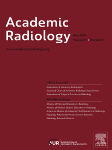
Publication date: Available online 29 November 2017
Source:Academic Radiology
Author(s): Jia-yan Ni, Jian Kong, Hong-liang Sun, Yao-ting Chen, Jiang-hong Luo, Wei-dong Wang, Dong Chen, Xiong-ying Jiang, Lin-feng Xu
Rationale and ObjectiveThe objective of this study was to analyze prognostic factors for survival after transarterial chemoembolization (TACE) combined with sorafenib for hepatocellular carcinoma (HCC) of Barcelona Clinic Liver Cancer (BCLC) stages B and C.Materials and MethodsClinical data of 198 patients with BCLC stage B and C HCCs who underwent TACE combined with sorafenib between June 2012 and January 2017 were retrospectively collected and analyzed. Survival curves were detected using log-rank test. Univariate analysis was performed using log-rank test with respect to 11 prognostic factors potentially affecting survival. All statistically significant prognostic factors identified by univariate analysis were entered into a Cox proportion hazards regression model to identify independent predictors of survival. P values were two-sided and P < 0.05 was considered statistically significant.ResultsBy the end of this study, the median follow-up duration was 43.6 months. The median overall survival (OS) of the patients was 21.0 months (95% confidence interval [CI]: 16.94–25.05), and the 1-, 2-, 3- and 5-year OS rates were 72%, 43%, 28%, and 4%, respectively. Tumor size (χ
2 = 33.607, P < 0.0001), tumor number (χ
2 = 4.084, P = 0.043), Child-Pugh class (χ
2 = 33.187, P < 0.0001), BCLC stage (χ
2 = 50.224, P < 0.0001), portal vein tumor thrombus (χ
2 = 88.905, P < 0.0001), Eastern Cooperative Oncology Group (ECOG) performance status (χ
2 = 98.007, P < 0.0001), extrahepatic spread (χ
2 = 34.980, P < 0.0001), TACE times (χ
2 = 8.350, P = 0.015), and sorafenib treatment strategy (χ
2 = 81.593, P < 0.0001) were found to be significantly associated with OS by univariate analysis. Multivariate analysis showed that BCLC stage (95% CI: 1.133–3.982, P = 0.019), extrahepatic spread (95% CI: 1.136–2.774, P = 0.012), and sorafenib treatment duration (95% CI: 0.352–0.574, P = 0.000) were independent prognostic factors associated with OS. There were no serious treatment-related adverse events.ConclusionsThis study showed that extrahepatic spread was a risk factor, and sorafenib treatment and superior BCLC stage were protective factors. Therefore, the study indicated that TACE combined with sorafenib was an effective and safe treatment for patients with BCLC stage B HCC without extrahepatic spread.
from #MedicinebyAlexandrosSfakianakis via xlomafota13 on Inoreader http://ift.tt/2jxEqmp
via
IFTTT
